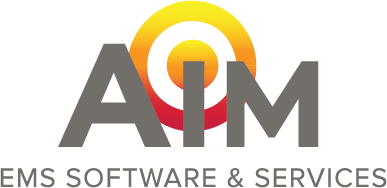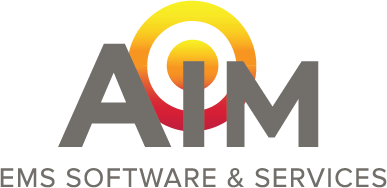
The right EMS software can improve your operations and financial health in measurable ways: Increasing reimbursements, reducing claim denials, enhancing patient care, saving time for field crews, and improving cash flow. But to realize those benefits, you need to transition to your new EMS software effectively.
Getting the right start with your EMS dispatch, ePCR, or billing software sets up your team to leverage all the value of the solution’s functionality. AIM has over three decades of experience helping leading EMS agencies transition to our software seamlessly, so we know what it takes to achieve a smooth implementation.
Why a Smooth EMS Software Transition is Essential
Implementing new EMS software often involves employees from various departments, encompassing operations and management, including team members who serve different functions and will use the same software in different ways. For example, a director, supervisor, and fire chief might use your EMS dispatch software, while field crew members and their supervisors will rely on ePCR software.
You need assurance that every staff member, no matter their role, is equipped to leverage your EMS software to work efficiently—especially at a time when skilled labor is hard to find and expensive, other costs are rising, and payers are squeezing your agency on reimbursement. A smooth, organized onboarding experience will provide each employee with the knowledge, skills, and confidence to maximum their use of the new EMS dispatch, ePCR, or billing software and complete their jobs faster and better.
What to Expect When You Transition to New EMS Software
EMS agencies that choose AIM software quickly discover the value of a seamless transition. Whether you’re implementing just one of our software solutions—or you’re bundling our EMS Dispatch, EMS ePCR, and EMS Billing Software for complete integration—our experienced team follows a transition plan that makes the process seamless and effective.The first step in any software implementation is ensuring you know what to expect. For example, AIM develops an implementation timeline that shows your team exactly what will happen at each stage. That’s particularly important when it comes to scheduling training for teams that work across different shifts.
The next step is to set up the software to your specifications. AIM’s development team typically spends one to two weeks preparing your EMS Dispatch, ePCR, or Billing Software, building out exactly what you need.
In AIM’s experience, the most important step in a successful transition to new EMS software is training. Effective training is designed around the specific needs of each function that will use the software, ensuring everyone is prepared to leverage the solution to do their jobs more effectively and efficiently.
Why Practical, Hands-On Training is a Must
Many EMS agencies report that their software providers take a hands-off approach to training—sometimes providing just a video tutorial. Yet, the functions that your EMS software handles are complex and nuanced.
For example, if you choose dispatch, ePCR, and billing software that’s purpose-built for EMS agencies, you’ll find you can configure it to support your unique workflows. That opens up a world of possibilities…but it also means your team needs guidance on how to take advantage of the software’s configurability and avoid becoming intimidated by the many options available.
To get your team off on the right foot and equip them to realize all the value in your new EMS software, your vendor should provide targeted, hands-on training. For example, AIM typically starts by training your software administrators. Then we provide additional sessions for your end users or train your in-house staff to conduct their own end user sessions, for agencies that prefer a train-the-trainer approach.
When you’re evaluating vendors for EMS dispatch, ePCR, or billing software, ask questions like these to ensure you’ll get the training support you need for a successful transition:
- What will the training cover? EMS software training should go beyond reviewing how to use key features and functions. For example, AIM training teaches your team how to complete the documentation necessary to ensure proper reimbursement and avoid claim denials, including documentation to support medical necessity.
- Will your trainers help with configurations? We also help you configure the system to work within and even enhance your workflows, avoiding delays, manual work, and other inefficiencies. Configurability is especially important for completing PCRs, but the sheer number of data points in NEMSIS can be intimidating. The trainers should build your team’s confidence in configuring PCR fields and others to suit your needs.
- Who will conduct the training? AIM trainers bring much more than a deep understanding of our software; they also understand how EMS agencies operate. Each trainer also specializes in a particular function, such as dispatch, ePCR, or billing. For example, our billing software trainer has been doing ambulance billing for 30+ years. Our trainers can help your staff apply best practices that improve your operations—whether it’s properly coding ambulance transports, handling the complexities of state-specific Medicaid rules, or setting up incident profiles by scenario type to save time.
- Is the training schedule well thought-out? To accommodate your shift schedules and minimize time out of the field, AIM organizes the training into brief sessions that focus on targeted topics. We also find it best to schedule these sessions several days apart, so participants can absorb new concepts before moving onto other topics.
- Is the training hands-on?For example, AIM trainers assign participants work to do between sessions, giving them immediate practice.
- What type of support is available? Once your training is completed, the software vendor should provide easy access to knowledgeable support representatives who respond to your questions quickly. For example, the AIM support team is available by phone, chat, or email, eliminating the need to submit a support ticket and wait days for a response.
When you make a smooth transition to your new EMS dispatch, ePCR, or billing software, your team gains more confidence using the tools that can help them operate more efficiently and help your agency improve profitability.;
Ready to improve your agency’s efficiency, profitability, and cash flow?
Schedule an AIM software demo today.
Or if you’re thinking about handling billing in-house, schedule a free billing evaluation.



